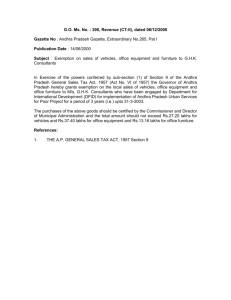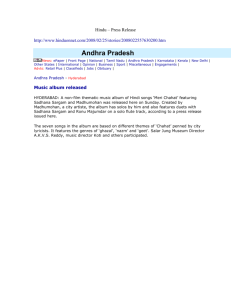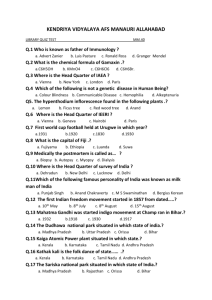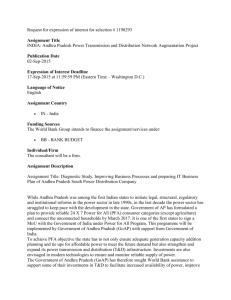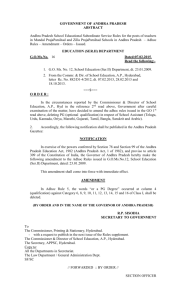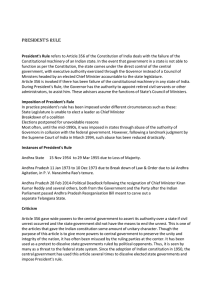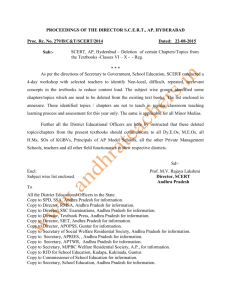s ic State Budget Analysis – FY17
advertisement
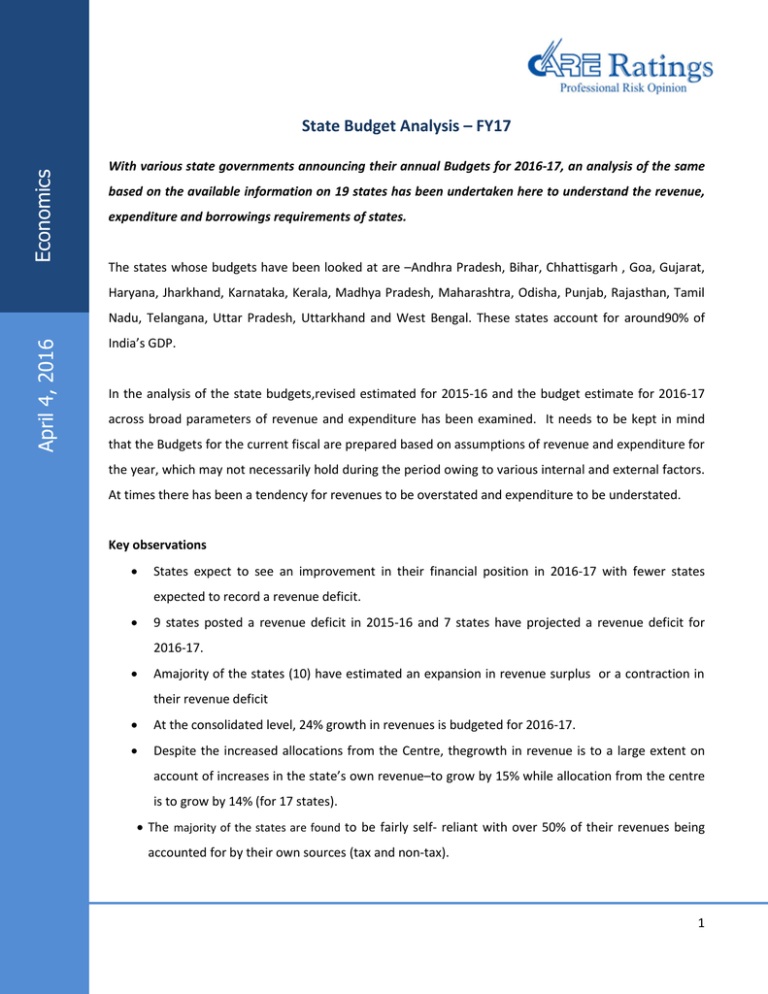
Economics State Budget Analysis – FY17 With various state governments announcing their annual Budgets for 2016-17, an analysis of the same based on the available information on 19 states has been undertaken here to understand the revenue, expenditure and borrowings requirements of states. The states whose budgets have been looked at are –Andhra Pradesh, Bihar, Chhattisgarh , Goa, Gujarat, Haryana, Jharkhand, Karnataka, Kerala, Madhya Pradesh, Maharashtra, Odisha, Punjab, Rajasthan, Tamil April 4, 2016 Nadu, Telangana, Uttar Pradesh, Uttarkhand and West Bengal. These states account for around90% of India’s GDP. In the analysis of the state budgets,revised estimated for 2015-16 and the budget estimate for 2016-17 across broad parameters of revenue and expenditure has been examined. It needs to be kept in mind that the Budgets for the current fiscal are prepared based on assumptions of revenue and expenditure for the year, which may not necessarily hold during the period owing to various internal and external factors. At times there has been a tendency for revenues to be overstated and expenditure to be understated. Key observations States expect to see an improvement in their financial position in 2016-17 with fewer states expected to record a revenue deficit. 9 states posted a revenue deficit in 2015-16 and 7 states have projected a revenue deficit for 2016-17. Amajority of the states (10) have estimated an expansion in revenue surplus or a contraction in their revenue deficit At the consolidated level, 24% growth in revenues is budgeted for 2016-17. Despite the increased allocations from the Centre, thegrowth in revenue is to a large extent on account of increases in the state’s own revenue–to grow by 15% while allocation from the centre is to grow by 14% (for 17 states). The majority of the states are found to be fairly self- reliant with over 50% of their revenues being accounted for by their own sources (tax and non-tax). 1 Economics At the aggregate level, revenue expenditure is estimated to grow by 12% during the current fiscal. The share of development revenue expenditure is seen to be on an average 58% of the total revenue expenditure and is estimated to grow by 11% in 2016-17. The interest to revenue ratio for most states is within the 15% target of the Finance Commission. Internal debt of the states (18 states) is budgeted to grow by 2.4% in 2016-17, from Rs. 3,97,679 cr in 2015-16 to Rs. 4,07,098 cr. Attemptsare being made by states to increase capital outlays. The consolidated growth in the same is likely to be 18% in 2016-17, from Rs. 3,46,939 crore in 2015-16 to Rs. 4,09,225 crore. States have been found to be striving to meet their commitments of fiscal consolidation. Most states have been maintaining their fiscal deficit within the target 3% of GSDP. Revenue Revenue Receipts The revenue of the state and the growth in the same is paramount to the state maintaining and augmenting its financial health and hencethe fiscal consolidation efforts. The increases in the States’ own revenue as well the devolutions from the centre (taxes and grants) play a decisive role in fiscal management. Revenue of states in 2016-17 at the aggregate level are budgeted to increase by 24%. - Telangana, Bihar, Uttarkhand, Andhra Pradesh and Goa are expected to register growth of over 20% - Kerala, Haryana and Rajasthan have budgeted 15 to 18% growth in revenues. - Uttar Pradesh, Madhya Pradesh, West Bengal, Gujarat, Maharashtra, Karnataka and Punjab have estimated growth rate of 10 to 14% for the fiscal. - Chhattisgarh is estimated to see the lowest growth in revenues at 4% followed by Odisha at 9%. With the centre now transferring higher quantum of central taxes to states (42% from the earlier 32%) based on the recommendation of the 14th Finance Commission (FC), the states are in receipt of higher tax allocations from the centre. Despite the higher devolution from the centre, thestates’ own revenue sources continue to be the mainstay of their revenue. Exhibit 1 shows that for a majority of statesown sources account for the larger share (over 50%) of total revenue. As such, the majority of states can be regarded as being fairly self-reliant. For the states analyzed here, own revenue on an average accounts for 58% of their total revenue and the same is estimated to grow by 15% in 2016-17 (exhibit 2). State Budget Analysis: FY17 2 Economics - Gujarat, Karnataka, Kerala, Punjab, Andhra Pradesh, Telangana, Rajasthan, Goa, Maharashtra, Haryana and Tamil Nadu can be regarded as being increasingly self-reliant. - Telangana is projected to witness high growth of 40% in its own revenue in this fiscal. - Goa and Haryana has estimated growth of 25% and 20% respectively. - Kerala has projected 18% growth in its own revenues, Maharashtra 13% and Gujarat and Karnataka 11% each. - Punjab is likely to see a mere 6% increase in its own revenues in the current fiscal. Allocations from the centre are budgeted to grow in the range of 4-30% in 2016-17, as illustrated in Exhibit 2. While the increase in share in central taxes for the states is estimated to be 12%, the allocation of grants from the centre varies significantly across states – it is estimated to increase by a high of 57% in Bihar, 52% in Andhra Pradesh, 25% in Kerala, 36% in Punjab and 30% in Uttarkhand while contracting by 2% in Haryana and marginally in Maharashtra. 74 80 72 70 50 53 47 40 28 26 30 69 68 55 54 46 52 48 45 58 42 54 46 31 35 54 46 42 32 31 31 58 58 30 28 26 23 20 Tamil Nadu Haryana Source: State Budget Documents State Budget Analysis: FY17 3 Uttrakhand Allocation from centre Haryana Uttrakhand 7 Maharashtra Maharashtra Goa 14 13 Telangana Telangana 12 Goa Odisha Jharkhand West Bengal Odisha 10 8 4 Rajasthan State's Own Revenue Punjab -3 Madhya Pradesh Jharkhand 20 26 22 0 -5 Kerala West Bengal 8 10 5 Karnataka Punjab 20 17 17 13 15 13 12 1112 1111 Gujarat Rajasthan 1918 16 Chhattisgarh State's own revenue 21 16 Bihar Madhya Pradesh 25 Andhra Pradesh Kerala 5 Gujarat 0 Karnataka 10 Chhattisgarh 28 25 10 Andhra Pradesh 30 30 15 Allocations from centre 40 40 70 20 Bihar % 60 69 69 45 74 77 % 90 Exhibit 2: Growth in Revenue - State's Own Revenue and Allocation from Centre (2016-17) Exhibit 1: Share in Revenue - Allocations from Centre and State's own Revenue (2016-17) Economics Capital receipts Capital Receipts at the consolidated level are slated to contract by 1% in 2016-17. Internal debt accounts for nearly 80% of Capital Receipts and loans from the centre for around 5%. The growth in these has been projected at 2% and 4% respectively in 2016-17.While states have been found to increasingly resort to market borrowings, the y-o-y growth in internal debt shows wide variations. - Karnataka and Telangana have estimated growth of nearly 50% in internal debt, while Odisha and Punjab have put the growth rate at around 40%. - It is in the range of 20-25% for Madhya Pradesh, Maharashtra, Bihar, Uttarkhand, Chattisgarh,Gujarat and Andhra Pradesh. - Kerala and West Bengal have estimated lower increases in the same at 13% and 6% respectively given the high debt burden they already carry. - Jharkhand, Haryana,Rajasthan and Uttar Pradesh are to witness decline in internal debt this fiscal. Internal debt of Jharkhand is budgeted to decline by 11% y-o-y (from Rs.2087 cr to Rs.1860 cr), Haryana by 19% (from Rs. 31,275 cr to Rs.25,223 cr), Rajasthan by 37% (from Rs.61,002 cr to Rs. 38,429) and Uttar Pradesh by 25% (from Rs. 77,422 cr to Rs. 58261 cr). Expenditure Revenue Expenditure Revenue expenditure of states at the consolidated level is anticipated to increase by a modest 12% in 2016-17. While most states are estimated to witness their expenditure grow around this level, Andhra Pradesh, Telangana and Uttarkhand have estimated a growth of over 20% in revenue expenditure. Chattisgarh has budgeted growth of 3%. States have been found to be incurring higher development expenditure (58% of revenue expenditure), which is slated to grow by 11% this fiscal. Interest payments are estimated to account for 12% of revenue expenditure and are to grow by an average 18%. With the states focusing on attaining fiscal consolidation targets, they have been found to be curtailing their non-developmental expenditure. However, the states are seen to be pressured by higher expenditure in relation to their revenue, resulting in deficits. The Thirteen Finance Commission has set the target ratio for interest payment to revenue receipts at 15%. Barring Punjab, West Bengal and Haryana, all the other states are expected to attain this target in 2016-17. Most states State Budget Analysis: FY17 4 Economics have been found to be in adherence to this ratio. In 2015-16, in addition to the mentioned 3 states, Gujarat and Kerala saw this ratio to be marginally higher than the given target at 15.7% and 15.3% respectively (Exhibit 3). 25.0 Exhibit 4: Capital Outlay 20.6 21.4 Exhibit 3: Interest to Revenue Receipts (%) 80000 70000 Rs. Crore 11.9 5.8 7.1 7.7 40000 30000 10000 0 0.0 Uttrakhand Haryana Maharashtra Telangana Goa Odisha Jharkhand West Bengal Rajasthan Punjab Madhya Pradesh Kerala Karnataka Gujarat Chhattisgarh Bihar Andhra Pradesh FY16 (RE) Andhra Pradesh Bihar Chhattisgarh Gujarat Karnataka Kerala Madhya Pradesh Punjab Rajasthan West Bengal Jharkhand Odisha Goa Telangana Maharashtra Haryana Uttrakhand Uttar Pradesh Tamil Nadu 5.0 50000 20000 3.5 7.2 10.0 9.0 9.3 10.6 11.2 15.0 60000 15.3 14.3 13.9 15.3 15.7 20.0 FY17 (BE) FY16 (RE) FY17 (BE) Source: State Budget Documents Capital Expenditure Capital outlays account for the major portion of capital expenditure, as much as 95% in some states (average share is around 75%). The consolidated growth in the same is likely to be 18% in 2016-17, from Rs. 3,46,939 crore in 2015-16 to Rs. 4,09,225 crore. Efforts are being made by state to increase capital outlays that will help stimulate and sustain their economic growth prospects. Repayment of public debt that has a share of around 15% in capital expenditure has been estimated to grow by around 6% in 2016-17. - Wide variations in growth rates of capital outlay (y-o-y) have been observed across states. States such as Andhra Pradesh, Chattisgarh, Karnataka, Kerala, West Bengal, Jharkhand, Madhya Pradesh, Tamil Nadu and Telangana have budgeted growth in the range of 20-85%. - Rajasthan, Maharashtra, Gujarat, Odisha and Punjab are estimated to see growth in the range of 0.3 – 10%. - Bihar, Goa and Uttarkhand to grow around 15- 18%. - Uttar Pradesh is estimated to see a contraction of 2.3% in capital outlay in 2016-17. State Budget Analysis: FY17 5 Economics Deficits The Finance Commission has set a target of zero revenue deficit for states and gross fiscal deficit of not more than 3% of GSDP. States have been found to have not complied with these targets, especially the zero revenue deficit targets. 9 states posted revenue deficit in 2015-16. This is due to revenues unable to keep pace with expenditure. Also with the Centrally Sponsored Schemes being transferred to the States, the states have been required to incur expenditure on the same. Gross Fiscal Deficit Exhibit 5: Gross Fiscal Deficit to GSDP (%) FY16 (RE) 5.85 7.00 FY17 (BE) % Change 6,832 8,111 18.73 Gujarat 22,177 24,619 11.01 2.99 Chhattisgarh 1.93 1.59 3.00 2.28 2.16 4.00 3.79 -43.82 2.90 3.50 16,014 3.62 3.00 28,505 3.49 3.49 Bihar 3.02 3.03 5.00 2.79 2.12 20.54 2.25 2.25 20,497 2.72 2.88 17,005 2.87 Andhra Pradesh 2.82 2.99 6.00 2.00 Punjab 12,233 13,087 6.98 Rajasthan 24,386 23,014 -5.62 West Bengal 20,030 19,470 -2.80 Jharkhand 5,157 5,633 9.22 Odisha 9,932 14,532 46.32 Karnataka FY16 (RE) FY17 (BE) Source: State Budget Documents Maharashtra 17.70 Telangana 24,914 Odisha 21,167 Jharkhand Madhya Pradesh Rajasthan 0.00 Madhya Pradesh 12.72 Kerala Kerala Gujarat 23.17 20,003 Chhattisgarh 25,732 17,745 Bihar 20,892 Andhra Pradesh Karnataka 1.00 1,959 2,002 2.21 Telangana 16,912 23,467 38.76 Maharashtra 37,950 35,031 -7.69 Haryana 30,413 25,138 -17.34 4,749 6,073 27.88 Goa Uttarkhand States expect to see an improvement in their financial position in 2016-17 with fewer states estimated to record a revenue deficit. 7 states have projected a revenue deficit for 2016-17. The majority of the states (10) have estimated an expansion in revenue surplus or a contraction in their revenue deficit. State Budget Analysis: FY17 6 Economics Revenue Surplus (+)/Deficit (-) FY16 (RE) Uttar Pradesh FY17 (BE) 18,368 28,201 Odisha 6,829 3,683 Jharkhand 5,357 6,995 Chhattisgarh 3,948 5,037 Gujarat 3,657 3,236 Karnataka 999 522 Madhya Pradesh 437 3,510 Uttarkhand 282 25 Telangana 61 3,718 -137 159 Bihar -1,484 14,649 West Bengal -3,869 0 Andhra Pradesh -4,140 -4,868 Rajasthan -5,232 -8,802 Punjab -7,561 -7,983 Maharashtra -9,290 -3,645 Haryana -10,693 -12,280 Kerala -10,814 -9,897 NA -9,155 Goa Tamil Nadu Source: State Budget Documents Conclusions - States have been found to be making efforts at fiscal consolidation and to adhere to the target set by the Finance Commission mainly with regard to the fiscal deficit and interest to revenue receipts. - There have however been slippages on the revenue account with many states unable to maintain the target of zero revenue deficits, which in turn curtails their capital outlays. o Despite higher devolutions from the Centre along with greater flexibility in the use of these resources, the fiscal position of states has deteriorated. o At the same time states have been seen to fine tuning their expenditure towards productive and developmental purposes. - The proposed increase in capex by around 18% is significant and will be useful for boosting the level of investment in the economy. - Growth in overall market borrowings would be stable in FY17. State Budget Analysis: FY17 7 Economics Contact: Disclaimer Madan Sabnavis, Chief Economist, 022-6754 3489 This report is preparedby the Economics Division of Credit Analysis &Research Limited [CARE]. CARE has taken utmost care to ensure Kavita Chacko, Economist, 022-6754 3687 accuracy and objectivity while developing this report based on information available in public domain. However, neither the accuracy nor of information contained in this report is guaranteed. Dr. completeness Rucha Ranadive, Associate Economist, 02267543609CARE is not responsible for any errors or omissions in analysis/inferences/views or for results obtained from the use of information contained in this report and especially states that CARE (including all divisions) has no financial liability whatsoever to the user of this report. Disclaimer This report is preparedby the Economics Division of Credit Analysis &Research Limited [CARE]. CARE has taken utmost care to ensure accuracy and objectivity while developing this report based on information available in public domain. However, neither the accuracy nor completeness of information contained in this report is guaranteed. CARE is not responsible for any errors or omissions in analysis/inferences/views or for results obtained from the use of information contained in this report and especially states that CARE (including all divisions) has no financial liability whatsoever to the user of this report. State Budget Analysis: FY17 8
